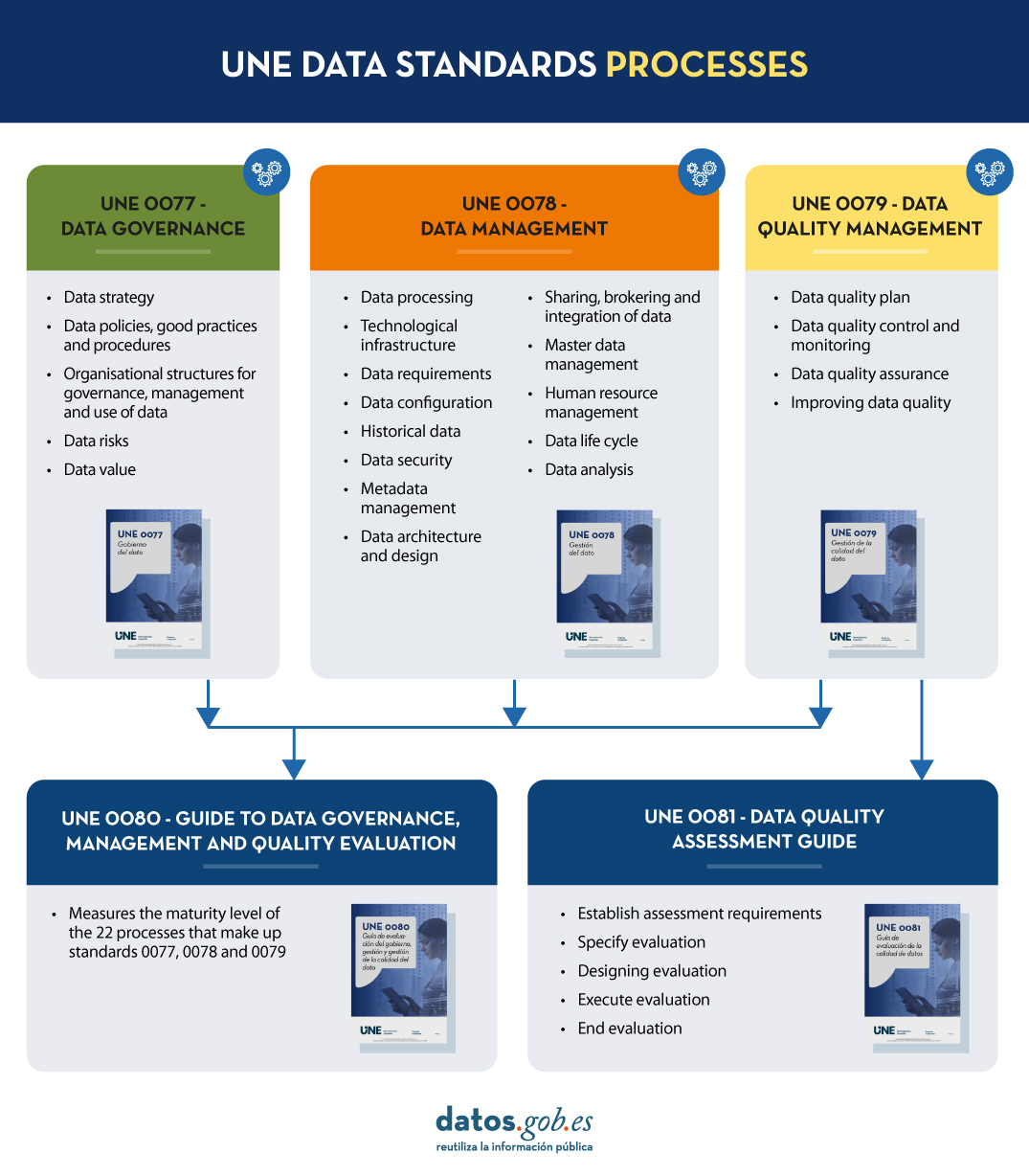
As tradition dictates, the end of the year is a good time to reflect on our goals and objectives for the new phase that begins after the chimes. In data, the start of a new year also provides opportunities to chart an interoperable and digital future that will enable the development of a robust data economy robust data economy, a scenario that benefits researchers, public administrations and private companies alike, as well as having a positive impact on the citizen as the end customer of many data-driven operations, optimising and reducing processing times. To this end, there is the European Data Strategy strategy, which aims to unlock the potential of data through, among others, the Data Act (Data Act), which contains a set of measures related to fair access to and use of data fair access to and use of data ensuring also that the data handled is of high quality, properly secured, etc.
As a solution to this need, in the last year the uNE data specifications which are normative and informative resources for implementing common data governance, management and quality processes. These specifications, supported by the Data Officethese specifications, supported by the Data Office, establish standards for well-governed data (UNE 0077), managed (UNE 0078) and with adequate levels of quality (UNE 0079), thus allowing for sustainable growth in the organisation during the implementation of the different processes. In addition to these three specifications, the UNE 0080 specification defines a maturity assessment guide and process to measure the degree of implementation of data governance, management and quality processes. For its part, the UNE 0081 also establishes a process of evaluation of the data asset itself, i.e. of the data sets, regardless of their nature or typology; in short, its content is closely related to UNE 0079 because it sets out data quality characteristics. Adopting all of them can provide multiple benefits. In this post, we look at what they are and what the process would be like for each specification.
So, with an eye to the future, we set a New Year's resolution: the application of the UNE data specifications to an organisation.
What are the benefits of your application and how can I access them?
In today's era, where data governance and efficient data management have become a fundamental pillar of organisational success, the implementation of the uNE data specifications specifications emerge as a guiding light towards excellence, leading the way forward. These specifications describe rigorous standardised processes that offer organisations the possibility to build a robust and reliable structure for the management of their data and information throughout its lifecycle.
By adopting the UNE specifications, you not only ensure data quality and security, but also provide a solid and adequate basis for informed decision-making by enriching organisational processes with good data practices. Therefore, any organisation that chooses to embrace these regulations in the new year will be moving closer to innovation, efficiency and trust in data governance and management; as well as preparing to meet the challenges and opportunities that the digital future holds digital future. The application of UNE specifications is not only a commitment to quality, but a strategic investment that paves the way for sustainable success in an increasingly competitive and dynamic business environment because:
- Maximising value contribution to business strategy
- Minimises risks in data processing
- Optimise tasks by avoiding unnecessary work
- It establishes homogeneous frameworks for reference and certification
- Facilitates information sharing with trust and sovereignty
The content of the guides can be downloaded free of charge from the AENOR portal via the links below. Registration is required for downloading. The discount on the total price is applied at the time of checkout.
- SPECIFICATION UNE 0077:2023
- SPECIFICATION UNE 0078:2023
- SPECIFICATION UNE 0079:2023
- SPECIFICATION UNE 0080:2023
- SPECIFICATION UNE 0081:2023
From datos.gob.es we have echoed the content of the same and we have prepared different didactic resources such as this infographic or this explanatory video.
How do they apply to an organisation?
Once the decision has been taken to address the implementation of these specifications, a crucial question arises: what is the most effective way to do this? The answer to this question will depend on the initial situation (marked by an initial maturity assessment), the type of organisation and the resources available at the time of establishing the master plan or implementation plan. Nevertheless, at datos.gob.es, we have published a series of contents prepared by experts in technologies linked to the data economy datos.gob.es, we have published a series of contents elaborated by experts in technologies linked to the data economy that will accompany you in the process.
Before starting, it is important to know the different processes that make up each of the UNE data specifications. This image shows what they are.

Once the basics are understood, the series of contents 'Application of the UNE data specifications' deals with a practical exercise, broken down into three posts, on a specific use case: the application of these specifications to open data. As an example, a need is defined for the fictitious Vistabella Town Council: to make progress in the open publication of information on public transport and cultural events.
- In the first post of the series, the importance of using the UNE 0077 data using the UNE 0077 Data Governance Specification to establish approved mechanisms to support the openness and publication of open data. Through this first content, an overview of the processes necessary to align the organisational strategy in such a way as to achieve maximum transparency and quality of public services through the reuse of information is provided.
- The second article in the series takes a closer look at the uNE 0079 data quality management standard and its application in the context of open data and its application in the context of open data. This content underlines that the quality of open data goes beyond the FAIR principles fAIR principles principles and stresses the importance of assessing quality using objective criteria. Through the practical exercise, we explore how Vistabella Town Council approaches the UNE processes to improve the quality of open data as part of its strategy to enhance the publication of data on public transport and cultural events.
- Finally, the uNE 0078 standard on data management is explained in a third article presenting the Data Sharing, Intermediation and Integration (CIIDat) process for the publication of open data, combined with specific templates.
Together, these three articles provide a guide for any organisation to move successfully towards open publication of key information, ensuring consistency and quality of data. By following these steps, organisations will be prepared to comply with regulatory standards with all the benefits that this entails.
Finally, embracing the New Year's resolution to implement the UNE data specifications represents a strategic and visionary commitment for any organisation, which will also be aligned with the European Data Strategy and the European roadmap that aims to shape a world-leading digital future.